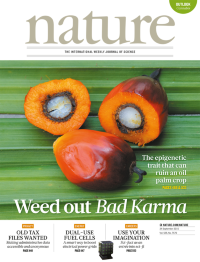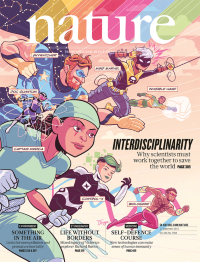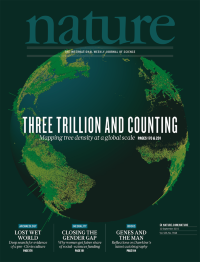Volume 525
-
No. 7570 24 September 2015
A flower and fruit abnormality known as mantled� can develop in some agricultural oil palm cultivars derived from tissue culture and the resulting mantled palms can become unproductive. Mantling is widely regarded as an epigenetic trait, but has not been fully explained. Meilina Ong-Abdullah et al. have undertaken a genome-wide, unbiased, DNA methylation analysis to look for loci epigenetically associated with the mantled phenotype. They find that hypomethylation of a single Karma family retrotransposon embedded in the intron of a homeotic gene is common to all mantled clones and associated with aberrant splicing and termination of the gene transcript. Loss of methylation � dubbed the Bad Karma epiallele � predicts a loss of oil palm yield and this property should enable screening for higher-performing clones at the plantlet stage. Cover: slpu9945/Thinkstock
Nature Outlook
-
No. 7569 17 September 2015
To tackle the challenges facing society � energy, water, climate, food, health � scientists and social scientists must work together. Yet research that transcends traditional academic boundaries is still unfashionable and poorly rewarded. This special issue of Nature examines what governments, funders, journals, universities and academics must do to make interdisciplinary work a joy rather than a curse. Cover: Dean Trippe
-
No. 7568 10 September 2015
A three-dimensional representation of a world of trees� based on a new map of global tree density. Features and countries you can see have trees, the others (like the Sahara) have virtually none. Until now, our understanding of global forest ecosystems has been generated from satellite information that can tell us about the area of forest. Policy makers and environmental scientists have relied heavily on this information when considering trees� involvement in patterns of biodiversity, biogeochemical cycles and their contribution to ecosystem services. Thomas Crowther et al. have extended the scope of this information by generating a map of global tree density that reveals what is going on below the canopy. The map, which was generated using more than 400,000 ground-sourced measurements of tree density, reveals patterns in tree numbers at regional and global scales. Using this map, the authors are able to estimate that the current global tree number stands at approximately 3 trillion. Cover art: Jan Willem Tulp using Processing (http://processing.org/)
-
No. 7567 3 September 2015
The outputs from numerical weather prediction (NWP) models are pervasive throughout society, and now provide skillful forecasts a week into the future. Looking back several decades, the increase in forecasting accuracy has been remarkable, but it was gradual, amounting to about an extra day of skillful forecast lead time per decade. Peter Bauer and colleagues review the many technological and scientific advances that have brought NWP to its present level, and reveal the considerable challenges in the future, if the historical rate of improvement is to continue. (Cover: Kelly Krause /Nature/Images by AijaK-Shutterstock)




